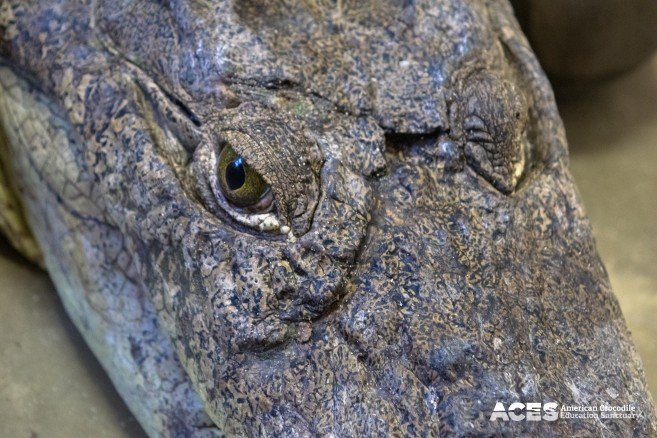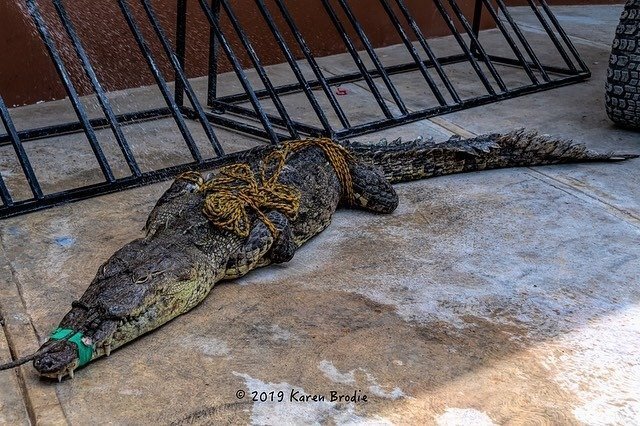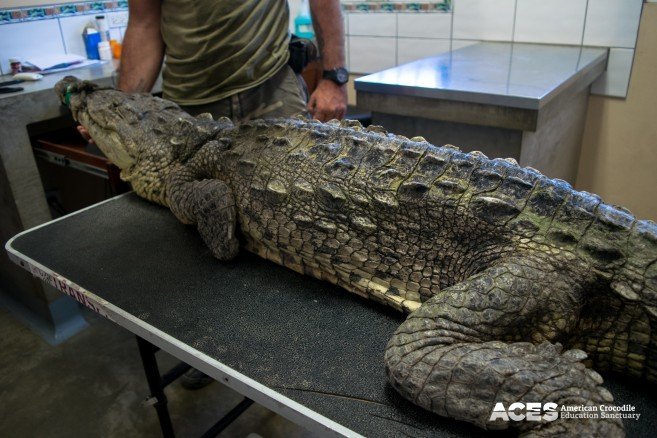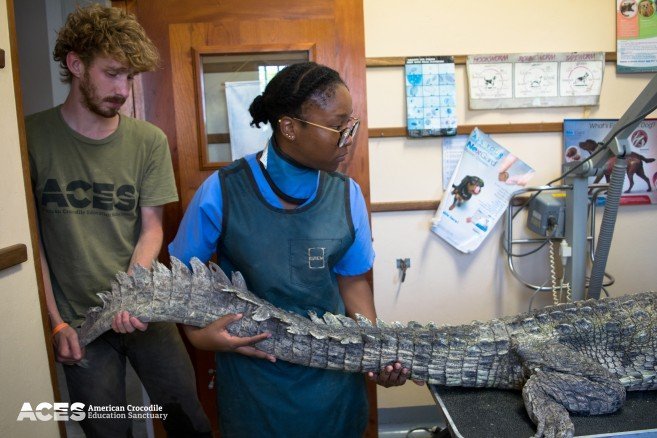On August 20th, two members of American Crocodile Education Sanctuary’s (ACES) team witnessed a man feed a wild American crocodile frozen chicken in a sealed plastic bag. The croc disappeared beneath the surface with the indigestible “treat” before anyone could stop it.
As the team watched in sorrow, the man tried to calm them, claiming the bag was ‘biodegradable’ and ‘not harmful to the animal.’ What this man does not know is that biodegradable items must have an ideal environment to begin the degradation process, one that includes UV light and oxygen, both of which are not found in a crocodile’s stomach. Even if these conditions are met, the process can take up to six months before breakdown occurs. Never-the-less, one should never feed a wild animal – especially not something encased in any sort of bag.
Alarmed by the information that this “treat” has been given to this croc on a regular basis, our team and volunteers set out over the course of the next week in the mornings and evenings in an attempt to capture the croc and flush her stomach to expel the accumulated trash before any blockages became life-threatening.
Unfortunately, due to the irresponsible actions of another individual nearby, who has also been feeding the crocs and habituating them to people, our task was easier said than done. During one evening’s investigation, we had six adult crocodiles coming to us seeking out food before we identified a croc who was in serious trouble with her health. Even in the dark of night, with flashlights barely piercing the murky water, we were able to see for the briefest of moments how dangerously underweight this animal was, and she became our sole target for the evening.
Over the next 4.5 hours, we tried everything we could to capture her, whilst at the same time making sure we didn’t catch or become caught ourselves by any of the other crocs who were increasingly interested in our presence and bait. After several near misses and hours of frustration, shortly before 1AM the team finally got a rope around our target crocodile and brought her onto the shore.
What we saw stopped us all in our tracks. It’s been a long time since I’ve seen a croc looking that bad, but for the two remaining members of the team it was their first time, and it brought tears to their eyes. To say she was underweight is a drastic understatement. This helpless animal was skin and bones. At nine feet long, she could not have weighed more than 100lbs, approximately half of what her weight should be, and she displayed external body conditions, indicating very poor health.
As well as her obviously dangerous weight, poor Elda, as she’s now become known, had peeling skin all over her body; not just a little, she had a lot of skin coming off. Since crocs don’t shed their skin like other reptiles, this is usually an indication that the animal has spent a considerable amount of time in polluted and toxic waters. She had vision in only one eye, and the pupil in that eye had little constriction in response to light. This is a bad sign, as every time we’ve observed this lack of pupil response, the croc has died within three days.
Her body also had bite marks all over it, some old, some new, and was missing her front foot. That being said, we weren’t surprised to find wounds such as this, as fighting is to be expected when you have large amounts of wild predators in one area who aren’t naturally a very social species. We typically only see this species hanging out in high concentration due to their behavior being altered by people feeding them. Unless you witness them fighting, they seem to be living harmoniously, but captures of such animals and inspections of their bodies, show this to not be the case – as was demonstrated by Elda’s body condition. Though Elda’s health looked to be in an extraordinarily fragile and declining state, her ability to somewhat fight the capture and interest in food gave us hope that she may be able to pull through if she immediately received the proper care.
So began her journey. It was clear that Elda was in need of medical attention and daily monitoring if she was to have any chance of surviving. With there being no vet on the island, and all of ACES rehab ponds at capacity, we began immediately making arrangements to get her to a vet on the mainland, and then on to Crocodile Research Coalition’s (CRC) facility for post-veterinary monitoring.
The following morning Elda was loaded onto a boat and headed for the mainland. The first stop was the Animal Medical Centre, where she was x-rayed, and the worst of her wounds thoroughly cleaned. She was then taken to the Belize Zoo to spend the night in a holding area where she could be free of ropes and could de-stress, as her holding pen at CRC was not ready till the following day. The following morning, members of the CRC team arrived to take her to a rehabilitation habitat, where she could be monitored on a daily basis and allowed to recover in a low-stress environment.
Sadly, despite the incredible team effort of all people and organizations who came together to save this animal’s life, 20 hours after being placed into a rehabilitation enclosure, Elda succumbed to her ill health and passed away. A necropsy performed by CRC shortly after showed she had a myriad of health issues, including infection in multiple organs, but the most shocking: three plastic grocery bags and a piece of metal inside her stomach. Elda’s cause of death was determined to be infection, exacerbated by external stressors in the environment (i.e., pollution). The ingested plastic bags and a deep cranial injury are also believed to have worsened this crocodile’s declining health.
Working in crocodile conservation, I’ve unfortunately seen a lot of dead crocs throughout my career. I’ve seen crocs who have been shot, stabbed, beaten, stoned, and tortured. I’ve seen crocs who were beheaded for trophies, crocs who were killed purely for their teeth to make trinkets to sell to tourists, crocs who have had their entire tails macheted off while alive, and I’ve seen crocs who have had their mouths tied shut prior to release so they can endure a slow and agonizing death through starvation over many months. Some of these deaths really get to you. Sometimes you can just shrug them off and carry on. This one has gotten to me. This animal did not suddenly fall ill and die. This is the result of years of accumulating ill health from living in a sick environment.
Now there maybe some of you reading this that scoff at my description or at the sadness we feel. You may think to yourself that she was just a croc, but she was not JUST a croc. She was an innocent, living, breathing, native Belizean animal, and despite the labels given to crocs, despite the fear, hatred, and myth surrounding these creatures, there is no evil in them, there is no malice. They do not attack indiscriminately, kill for pleasure, or hunt for sport. They are just another of God’s creatures trying to live amongst us, and this creature suffered and died because of the toxic environment in an ecosystem in which she should have thrived. She died because of the selfish actions, and disrespect mankind has shown the environment.
And what saddens me more than the death of an individual wild animal, is what this death represents. As an indicator species, crocodiles provide us an insight into the health of the environment. There is a direct correlation between the health, growth, and survivability of the overall population of crocodilians and the health of the ecosystem. If species such as crocodiles with their incredible immune systems are showing ill health or are dying because of the environment, they’re in, that is a very worrying sign that our ecosystem is unhealthy. Here in Belize, our awe-inspiring ecosystem draws visitors from all over the world and this, in turn, provides jobs to a large portion of the country’s citizens. Despite this, though, we see trash being tossed on the side of the road, boatloads of garbage being dumped in the lagoon waters, and trash being used to fill land situated at sea level, resulting in toxic runoff into the waterways. We are destroying the very thing that gives us our livelihood.
So what are we going to do? Are we just going to wait? That didn’t work out so well for Orange Walk and the New River. The community there has known for years that there were problems in the waterways, but it seemed small enough it could be lived with, so that’s what most did, they lived with it, as we are now. Those that did make some noise weren’t listened to, and when the rains came and diluted the problem, it was largely forgotten until the next dry season. Now, with months of drought, the scale of the pollution is displayed in full and cannot be ignored. Crocodiles are being found dead, fish are dying off by the thousands, a thick residue coats the water’s surface, and restaurants, hotels, and even schools have sat empty as the stench from the river became unbearable.
Is that what we’re waiting for here on Ambergris Caye? For the ecosystems here to be so unbelievably damaged that the pollution can no longer be buried under neighborhoods or hidden in the ever decreasing amount of mangrove? If that happens, it’s already too late. If we get to a level that parallels the New River, what are the effects we will see on our precious reef, which is situated so close to our coastline. Are we potentially sending our reef a death sentence?
Every single person on this island either directly or indirectly relies on the reef and the tourism it brings. It doesn’t matter if you’re a gas station attendant, chef, tour guide, real estate agent, or fisherman. We ALL rely on the benefits of a healthy reef. In the worst-case scenario, if the reef dies, and the waters surrounding Ambergris Caye are putrid and foul, we lose our lifeline. Ambergris Caye has no other economy, and she won’t be able to return to a sleepy fishing village; with no mangrove, no reef, and toxic waters, there will be hardly any fish left, and what does survive may be riddled with toxins. All that will remain from paradise is crime, poverty, and regret that we didn’t act before it was too late.
So, may we all learn something from the innocent American crocodile who lost her life. Elda, whose name means Warrior, fought a battle against pollution. As human beings and the most intelligent species, we have the power through our daily actions to protect the environment on Ambergris Caye and preserve her for our future generations. Take pride in this jewel, take care of all of her inhabitants, and change it for the better.
We plead, if not for the safety of the community, our children, our pets, and our visitors, if you care for the wellbeing of our beloved wildlife, please stop feeding wild animals and report those that do.
ACES would like to thank all those who came together for Elda’s rescue: ACES Intern Joshua Callan, Volunteers Ben and Rae Sept, Thomas Ack, Karen Brodie, Fondation Brigitte Bardot, Las Terrazas Resort, Quality Poultry Products, Animal Medical Centre, The Belize Zoo, Crocodile Research Coalition, and Belize Forest Department. Please share Elda’s story to raise awareness of the environmental issues that plague our island. Though you may not be the reason these issues are occurring, it is the responsibility of us all to take action.
For more information, ACES can be contacted at +501-623-7920 or by emailing [email protected].
ACES is a non-profit organization permitted by the Belize Forest Department and dedicated to the conservation of Belize’s critical wetland habitats and protected species, specifically Crocodilians, through scientific research and education in order to preserve wildlife for future generations.

Share
Read more

